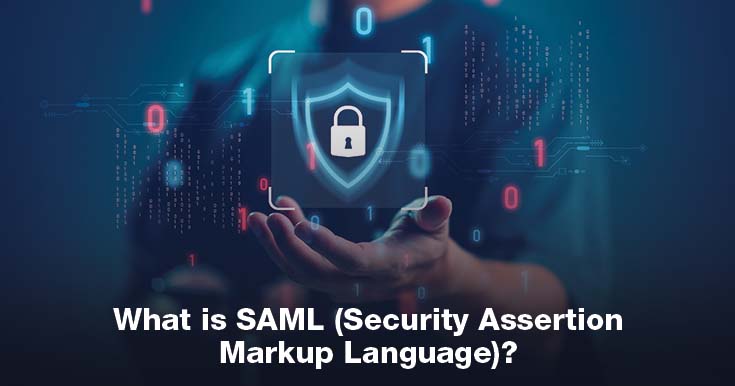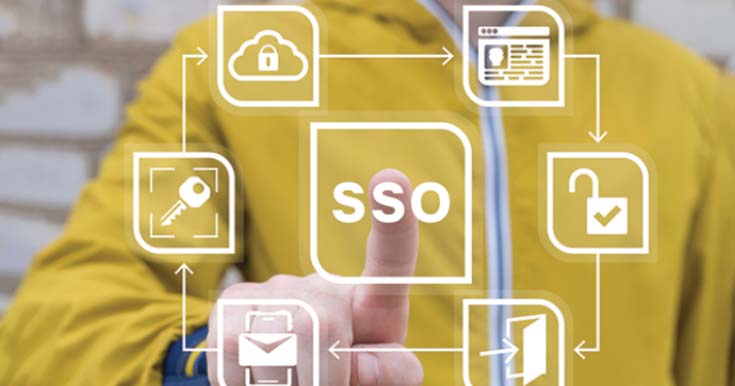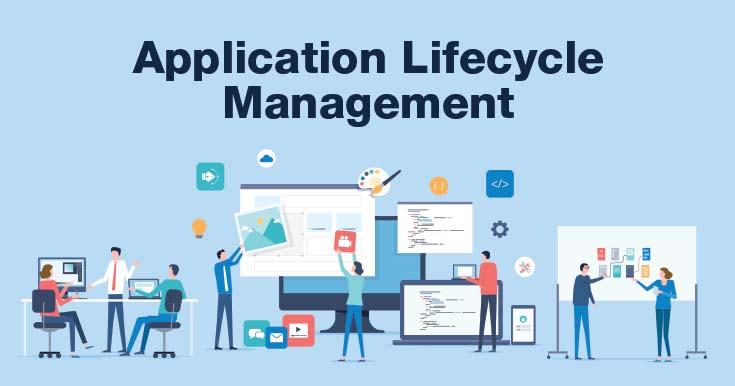What is SAML? How SSO SAML Authentication Works?

Overview
With the digital age comes many apps; thus, one must know how to access them safely. However, it can be tiresome and risky to remember different login credentials for each program. Enter SAML. It allows a person to sign in once and use that login for multiple apps. With SAML, businesses can eliminate the need for users to recall many passwords, thereby simplifying things while enhancing security.
In this blog post, you will learn about SAML (Security Assertion Markup Language) and its features such as Single Sign-On (SSO) which can make your workday more productive. We will first break down the basics of SAML and explain how it provides secure authentication.
What is SAML?
SAML or Security Assertion Markup Language is an open standard that enables an identity provider (IdP) and a service provider (SP) to exchange user authentication information securely.
Think of SAML as a trusted translator. Similar to your company’s login page, the IdP confirms who you are. It then translates this validation into a secure format recognizable by the SP, like a cloud application, which grants access rights on your behalf.
What is the use of Security Assertion Markup Language?
SAML makes the Single Sign-On (SSO) process simpler. Its main objective is to ensure that users can sign in once and access multiple applications using a single set of credentials. It has functionalities that are necessary for improving user experience, supporting security protocols, and simplifying access control in corporate IT systems. All these features enable its primary purpose, which is enabling SSO. Below are some areas where it can be applied:
- Sign in Once, Access Many Apps: With SAML, you only need to log in once through a central service (such as a company login). Then, you can get into many other apps without entering another password – so no more password overload!
- Safer Logins: SAML keeps your login information safe by storing it all in one trusted place, making it harder for hackers to steal different app passwords.
- Easier App Management for Organizations: Adding new apps into their system becomes easier with SAML which also allows businesses to control who can access them.
What is Single Sign-On (SSO)?
SSO is like having a master key. You only need to log in once to your IdP, and then you can access all your different apps without needing individual keys or passwords. It saves time and keeps things less cluttered!
- The user tries to open an app (Service Provider or SP).
- The app realizes it doesn’t do logins itself, so it sends the user over to the identity provider (IdP).
- The user logs in to the IdP using their login info.
- Once the IdP confirms it’s really the user, it creates a special document called a SAML assertion. This document has all the user’s info and what they’re allowed to do.
- The IdP sends this document back to the app.
- The app trusts the IdP and lets the user in without needing another login, using the info from the SAML assertion.
Thus, Single Sign-On (SSO) enables users to access many applications using one login by directing them from the app to the identity provider, where they sign in only once. After this, a special file is sent to that application from the identity provider so as to enable entry without asking for another username and password. Simple entrance; no more password problems!
Advantages of SAML Authentication
SAML authentication has many advantages for individuals and organizations alike. Here’s why it rocks:
- Enhanced User Experience: It saves time and makes life easier when users are not required to repeatedly log in; imagine being able to switch between different applications seamlessly without having to remember or type lots of passwords every single time.
- Stronger Security: This method reduces risks associated with passwords by channeling all logins through a central Identity Provider (IdP). Thereby lowering the chances of phishing attacks and stolen passwords and safeguarding sensitive data as well as organizational information.
- Simplified IT Management: Organizations can add new apps to their IT system easily since they follow uniform authentication rules. This simplifies things and decreases workloads on IT teams who can then concentrate on critical tasks instead of dealing with numerous different app logins.
- Cost Savings: With SAML, there’s no need to deal with and maintain separate app logins, which saves a bunch of IT resources. By centralizing the authentication process, organizations can work more efficiently and spend their resources more wisely.
SAML Authentication doesn’t just improve security and user satisfaction; it also makes IT asset management easier and saves organizations money.
How does SAML authentication work?
Now let’s look into its authentication on a technical level:
- SAML Provider: It is software that facilitates the exchange of information between IdP and SP. Some IdPs have it built-in, while others require a separate provider.
- SAML Assertion: This is an XML document containing user information such as username and access rights. The reason why it is signed by the IdP is to ensure its authenticity.
- SAML 2.0: This version is popular and widely used today; in fact, most people demand it because it has better security features than the previous editions and is also more flexible.
What is a SAML Provider?
A program referred to as a SAML provider acts as an intermediary during login between the identity provider (IdP) and service provider (SP). It works by creating, validating, and then sending SAML assertions which ensure a secure exchange of user credentials. Providers of this kind can be classified into two major types:
Integrated SAML provider: This type comes packaged within the IdP software hence offering simplicity since everything needed for authentication is available in one place.
Standalone SAML provider: A separate software tool that can be integrated with different IdPs and SPs thereby enabling organizations with complex IT environments to have more options.
What does the term “SAML Assertion” mean?
It is often regarded as the central part of communication about SAML assertion. In other words, it is a file that keeps users’ login securely through a specific format (XML). Basically, this contains such information as the name of the user, email address, and what he or she can do within the service provider (SP). Additionally, before sending an assertion over to SP; IdP signs it digitally so that authenticity plus security may be ensured.
What is SAML 2.0?
SAML 2.0 is the most frequently used version of this protocol. In comparison to the previous edition, it offers various needed upgradations, including:
- Better Security-Related Features: SAML 2.0 uses advanced techniques to keep your user information extra safe, like stronger passwords and codes.
- Greater flexibility: More options are available for signing in when using SAML 2.0 also organizations can control who accesses what data.
- Better integration with other applications (backward compatibility): There is improved support for apps from various companies on different login services with SAML 2.0 than any previous release did.
What is SSO Security Assertion Markup Language?
SSO SAML, or Single Sign-On Security Assertion Markup Language, is a widely used protocol for implementing single sign-on (SSO). As explained before, it works by securely exchanging user authentication data between an identity provider (IdP) and a service provider (SP), thus allowing people to sign in once and access multiple applications effortlessly.
Features of SSO SAML
Benefits are provided by SAML through Single Sign-On (SSO). It guards your information and makes logging in easier. Standard operating procedures together with strong security measures ensure that only authorized persons gain entry to the system while ensuring data protection.
- Standardization: This is made possible because it uses an open standard where various Identity Providers (IdPs) and Service Providers (SPs) can communicate and work seamlessly with one another. With this method being universalized across many IT environments, integrations become less difficult thus promoting interoperability.
- Stronger Security: A secret message protected by two layers of security such as a digital lock plus a special code that prevents tampering or even disclosure during transmission between systems — this is how user login info travels in SSO-SAML. Besides keeping it private, more effort is needed for hackers to hack into any organization using this technology.
- Scalability with Business Growth: Imagine having expandable trousers but for your apps – that’s what Scalability means in terms of SSO-SAML! The number of people signing up as well as applications being used may increase significantly over time especially when companies grow large hence additional resources will be required so as not to compromise on performance or security levels. So whether you’re small or big, rest assured everything will work fine.
- Flexibility: What Can You Access with SSO-SAML? Imagine that every user has their own key which fits only certain locks within your system. This is exactly what SSO-SAML does – it enables you to determine what each employee can or cannot do on your network. Such an approach helps maintain security while giving people all the necessary tools for performing their duties.
How does SSO SAML authentication work?

Let’s take a closer look at the steps behind the process:
- User Initiates Access: The person makes an attempt to reach some service provider application (referred to as SP).
- Redirection to IdP: Since this particular SP doesn’t deal with authentication itself, it recognizes this fact and sends the individual to its pre-configured IdP login page.
- IdP Validation: The user enters their login credentials in the IdP.
- SAML Assertion Formulation: In case of a successful login, the IdP generates what it calls an assertion. This document includes user data plus what they are permitted to do in the desired app.
- SAML Assertion Transfer: The IdP then sends this document back to the app securely.
- SP Verification: Upon receipt of the document, the application checks its validity using digital signatures from those issued by the IdPs which are considered trustworthy; thereby confirming that indeed this is not only a genuine but also a valid claim made by an authentic source.
- Access Authorization: If everything is found to be okay, based on information contained therein about a particular user who has already been authenticated once through some other means previously employed within an enterprise such as username/password combination – then there need not be any further requirement for another login attempt.
- Transparent Access: Once authenticated at the SSO level, end-users can seamlessly reach apps without having to re-enter their credentials again.
How DevTools Can Help Your Organization Implement Security Assertion Markup Language Authentication
For establishments seeking to incorporate SAML authentication into their systems, DevTools provides extensive support. We help in connecting DevTools’ package of instruments and steps with our knowledge of DevSecOps to make the adoption of SAML authentication easier. Our method is all about speeding up software development cycles via automation as well as security integration. By digitalizing procedures and promoting collaboration through Agile consulting plus DevOps principles, we enable businesses to achieve what they want faster. What sets apart this organization from others is that it focuses on modernization and collaboration; therefore, ensuring that any company can begin its digital transformation journey confidently with DevTools.
Conclusion
SAML is a standardized authentication method that changes the way Single Sign-On (SSO) works, making it faster for companies to authenticate themselves. Instead of having to use multiple login credentials at once, users can now authenticate through a trusted identity provider (IdP), which makes things easier and more productive for them.
In addition, this approach also strengthens security by eliminating the need for individual app passwords, thus reducing the chances of weak or reused credentials being used to compromise security. With everything in one place like this, organizations are able to implement stronger password policies and add more security measures at the IdP level.
Another benefit is that it makes IT management easier. This is because new applications can be integrated seamlessly into systems with little hassle on behalf of administrators; should any issues arise they can be dealt with quickly too. We help out in these areas by providing features for monitoring traffic, validating security certificates, and troubleshooting problems – all designed to keep SAML running smoothly.




